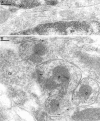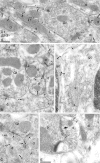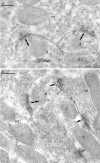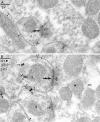Segregation of different GABAA receptors to synaptic and extrasynaptic membranes of cerebellar granule cells
- PMID: 9464994
- PMCID: PMC6792611
- DOI: 10.1523/JNEUROSCI.18-05-01693.1998
Segregation of different GABAA receptors to synaptic and extrasynaptic membranes of cerebellar granule cells
Abstract
Two types of GABAA receptor-mediated inhibition (phasic and tonic) have been described in cerebellar granule cells, although these cells receive GABAergic input only from a single cell type, the Golgi cell. In adult rats, granule cells express six GABAA receptor subunits abundantly (alpha1, alpha6, beta2, beta3, gamma2, and delta), which are coassembled into at least four to six distinct GABAA receptor subtypes. We tested whether a differential distribution of GABAA receptors on the surface of granule cells could play a role in the different forms of inhibition, assuming that phasic inhibition originates from the activation of synaptic receptors, whereas tonic inhibition is provided mainly by extrasynaptic receptors. The alpha1, alpha6, beta2/3, and gamma2 subunits have been found by immunogold localizations to be concentrated in GABAergic Golgi synapses and also are present in the extrasynaptic membrane at a lower concentration. In contrast, immunoparticles for the delta subunit could not be detected in synaptic junctions, although they were abundantly present in the extrasynaptic dendritic and somatic membranes. Gold particles for the alpha6, gamma2, and beta2/3, but not the alpha1 and delta, subunits also were concentrated in some glutamatergic mossy fiber synapses, where their colocalization with AMPA-type glutamate receptors was demonstrated. The exclusive extrasynaptic presence of the delta subunit-containing receptors, together with their kinetic properties, suggests that tonic inhibition could be mediated mainly by extrasynaptic alpha6beta2/3delta receptors, whereas phasic inhibition is attributable to the activation of synaptic alpha1beta2/3gamma2, alpha6beta2/3gamma2, and alpha1alpha6beta2/3gamma2 receptors.
Figures








Similar articles
-
Alterations in the expression of GABAA receptor subunits in cerebellar granule cells after the disruption of the alpha6 subunit gene.Eur J Neurosci. 1999 May;11(5):1685-97. doi: 10.1046/j.1460-9568.1999.00581.x. Eur J Neurosci. 1999. PMID: 10215922
-
Homeostatic competition between phasic and tonic inhibition.J Biol Chem. 2013 Aug 30;288(35):25053-25065. doi: 10.1074/jbc.M113.491464. Epub 2013 Jul 9. J Biol Chem. 2013. PMID: 23839941 Free PMC article.
-
Quantitative localisation of synaptic and extrasynaptic GABAA receptor subunits on hippocampal pyramidal cells by freeze-fracture replica immunolabelling.Eur J Neurosci. 2010 Dec;32(11):1868-88. doi: 10.1111/j.1460-9568.2010.07473.x. Epub 2010 Nov 14. Eur J Neurosci. 2010. PMID: 21073549 Free PMC article.
-
Extrasynaptic δ-subunit containing GABAA receptors.J Integr Neurosci. 2021 Mar 30;20(1):173-184. doi: 10.31083/j.jin.2021.01.284. J Integr Neurosci. 2021. PMID: 33834705 Review.
-
α6-Containing GABAA Receptors: Functional Roles and Therapeutic Potentials.Pharmacol Rev. 2022 Jan;74(1):238-270. doi: 10.1124/pharmrev.121.000293. Pharmacol Rev. 2022. PMID: 35017178 Review.
Cited by
-
Reduction in focal ictal activity following transplantation of MGE interneurons requires expression of the GABAA receptor α4 subunit.Front Cell Neurosci. 2015 Apr 9;9:127. doi: 10.3389/fncel.2015.00127. eCollection 2015. Front Cell Neurosci. 2015. PMID: 25914623 Free PMC article.
-
Characterization of GABAA receptor ligands with automated patch-clamp using human neurons derived from pluripotent stem cells.J Pharmacol Toxicol Methods. 2016 Nov-Dec;82:109-114. doi: 10.1016/j.vascn.2016.08.006. Epub 2016 Aug 18. J Pharmacol Toxicol Methods. 2016. PMID: 27544543 Free PMC article.
-
Diffusion barriers constrain receptors at synapses.PLoS One. 2012;7(8):e43032. doi: 10.1371/journal.pone.0043032. Epub 2012 Aug 13. PLoS One. 2012. PMID: 22912780 Free PMC article.
-
Tonic excitation and inhibition of neurons: ambient transmitter sources and computational consequences.Prog Biophys Mol Biol. 2005 Jan;87(1):3-16. doi: 10.1016/j.pbiomolbio.2004.06.001. Prog Biophys Mol Biol. 2005. PMID: 15471587 Free PMC article. Review.
-
The Delta-Subunit Selective GABA A Receptor Modulator, DS2, Improves Stroke Recovery via an Anti-inflammatory Mechanism.Front Neurosci. 2019 Oct 29;13:1133. doi: 10.3389/fnins.2019.01133. eCollection 2019. Front Neurosci. 2019. PMID: 31736685 Free PMC article.
References
-
- Andersen P, Eccles JC, Loyning Y. Recurrent inhibition in the hippocampus with identification of the inhibitory cell and its synapses. Nature. 1963;198:540–542. - PubMed
-
- Baude A, Nusser Z, Roberts JDB, Mulvihill E, McIlhinney RAJ, Somogyi P. The metabotropic glutamate receptor (mGluR1α) is concentrated at perisynaptic membrane of neuronal subpopulations as detected by immunogold reaction. Neuron. 1993;11:771–787. - PubMed
-
- Baude A, Nusser Z, Molnar E, McIlhinney RAJ, Somogyi P. High-resolution immunogold localization of AMPA type glutamate receptor subunits at synaptic and non-synaptic sites in rat hippocampus. Neuroscience. 1995;69:1031–1055. - PubMed
-
- Benke D, Honer M, Michel C, Mohler H. GABAA receptor subtypes differentiated by their γ-subunit variants: prevalence, pharmacology, and subunit architecture. Neuropharmacology. 1996;35:1413–1423. - PubMed
Publication types
MeSH terms
Substances
LinkOut - more resources
Full Text Sources
Other Literature Sources
Molecular Biology Databases
Miscellaneous
